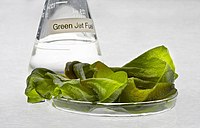
Photo from wikipedia
Wastewater from fertilizer industries is rich in ammoniacal nitrogen and orthophosphates. The present study demonstrates the recovery of nutrients from fertilizer industry effluent in the form of microalgal biomass to… Click to show full abstract
Wastewater from fertilizer industries is rich in ammoniacal nitrogen and orthophosphates. The present study demonstrates the recovery of nutrients from fertilizer industry effluent in the form of microalgal biomass to produce various bioproducts. The study demonstrates the integration of pilot-scale struvite production from fertilizer industrial wastewater in air-agitated reactor to phycoremediation of residual wastewater. The parameters required for the production of high yield and better quality of struvite were optimized. The microalgal consortium was isolated from anaerobic plant digestate and adapted to tolerate 1000 mg L −1 of NH 4 -N using synthetic wastewater rich in NH 4 -N. Pilot-scale struvite production was carried out in the air-agitated reactor (1 m 3 capacity) in batch mode and phycoremediation of residual effluent was carried out in tubular photobioreactor (200 L capacity) in fed batch mode. Pilot-scale struvite crystallization produced 60 kg of struvite from 1 m 3 of effluent. During struvite precipitation, 2.96% of COD, 68.29% of NH 4 -N, and 96.38% of PO 4 -P were recovered. The residual effluent was further phycoremediated by the microalgal consortium. During phycoremediation, 62.68% of COD, 59.21% of NH 4 -N, and 68.57% of PO 4 -P were recovered in terms of microalgal biomass. Due to integration, 64.58% of COD, 87.31% of NH 4 -N, 89.0% of TKN, and 98.79% of PO 4 -P are recovered. The observed yield (g m −3 effluent) of biomass, lipids, ω-3 fatty acid, and biogas (L m −3 effluent) was 290, 56, 11.2, and 80 L, respectively. In brief, the integration of struvite production and microalgae cultivation can be used as an effective treatment system for fertilizer industry wastewater. Graphical abstract
Journal Title: Journal of Applied Phycology
Year Published: 2020
Link to full text (if available)
Share on Social Media: Sign Up to like & get
recommendations!